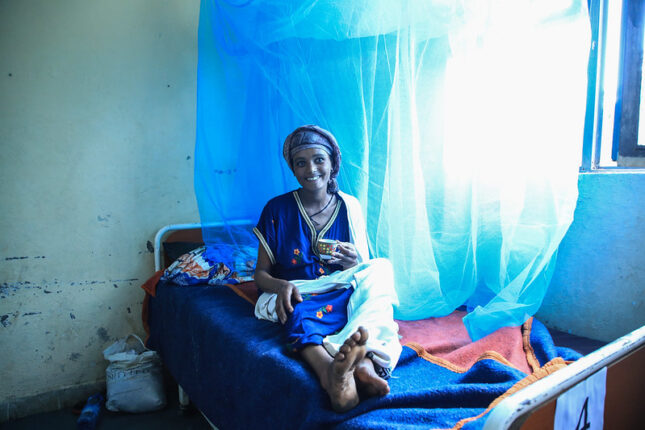-
Can Global Maternal Health Investments Help Eradicate Malaria?
January 30, 2024 By Deekshita Ramanarayanan
The last two decades saw significant gains in reducing the incidence of malaria, but can we be doing even more to eradicate this disease? In early January 2024, a New York Times op-ed argued that millions were dying needlessly as tools to defeat malaria were within reach.
Malaria is spread through infected mosquito bites, and it is most predominantly found in tropical and sub-tropical climates. So vaccination is at the center of these new strategies to combat malaria, and countries in affected regions—such as Cameroon—are now rolling out nationwide campaigns to vaccinate children against the disease.
However, there are still significant challenges to doing better. According to the latest report released by the World Health Organization (WHO), 2022 saw approximately 249 million cases of malaria infection across 85 countries globally, which is an increase of 5 million cases compared to 2021. And the COVID-19 pandemic, growing impacts of climate change, and emerging humanitarian emergencies all threaten progress towards 2025 prevention targets.
Where does maternal health fit into the battle to combat malaria? It is certainly the case that the disease has an outsized impact on pregnancy, maternal health, and newborn health outcomes. In 2022, 36 percent (12.7 million) of pregnancies across 33 moderate and high transmission countries in sub-Saharan Africa were exposed to malaria infection.
Malaria infection also significantly increases the risk of maternal death before and after childbirth – estimates indicate that more than 10,000 pregnant women die of malaria infection yearly. For pregnant women in their first or second trimester, or for pregnant women living with HIV, the risk of malaria infection may be even higher. Malaria infection can also lead to anemia—not enough healthy red blood cells– during pregnancy which is a major contributor to low birthweight, stillbirth, and preterm birth.
Promoting adequate prevention and treatment during pregnancy could avert more than 200,000 low birthweights, advancing progress towards reducing neonatal and childhood mortality globally.

What Works? What’s Needed?
The core range of interventions to prevent malaria infection in endemic countries include insecticide-treated mosquito nets, indoor residual spraying (IRS), antimalarial medication, and rapid diagnostic testing.
One intervention that puts maternal health at the center of efforts is Intermittent Preventive Treatment in Pregnancy (IPTp), which entails the administration of an antimalarial drug, such as 3 doses of sulfadoxine-pyrimethamine (SP), to all pregnant women regardless of their infection status. Yet IPTp cannot be administered during the first trimester of pregnancy, when 60% of malaria infections occur. During this period, insecticide-treated mosquito nets provide primary prevention to pregnant women. While these nets are an effective method of prevention, they are less effective when used without IPTp.
Societal barriers to gender equality can also hinder women and adolescent girls’ access to life-saving prevention and treatment options, particularly during. They also bear the brunt of the indirect costs of malaria, including unequal burdens in caregiving, a loss of schooling, and diminished economic opportunities.
Despite the progress being made, future emerging geopolitical threats will further threaten progress towards eradicating malaria. For instance, shifting temperatures, rainfall patterns, and extreme weather events due to climate change will expand the geographical range for the risk of malaria-infected mosquitos. For example, the 2022 floods in Pakistan resulted in a five-fold increase in malaria infection.
Increasing occurrences of humanitarian and health emergencies also disproportionately impact countries where malaria is endemic, resulting in further surges of malaria infection. New species of mosquitos such as the Anopheles Stephensi mosquito also pose a threat as they transmit infection with greater risk of severe infection and death—and show resistance to widely used insecticides.
Investments in new technologies and innovations to combat malaria and reduce the threat of malaria to maternal, newborn, and child health are key to stemming the tide.
Sources: Centers for Disease Control and Prevention, Down to Earth, Malaria Journal, Malaria No More, Medicines for Malaria Venture, Mayo Clinic, NBC News, The New York Times, Reuters, United to Beat Malaria, World Health Organization.
Photo Credit: Mastewal Kassa is days away from delivering her baby in a maternity waiting home with an insecticide-treated net in the background, courtesy of flickr user UNICEF Ethiopia/2021/Demissew Bizuwerk; Staff at the Maternal and Child Health Center in Barumbu, Kinshasa show packages of insecticide-treated bed nets to be distributed to pregnant women at the prenatal clinic., courtesy of flickr user Kaukab Jhumra Smith/USAID.
 A Publication of the Stimson Center.
A Publication of the Stimson Center.




